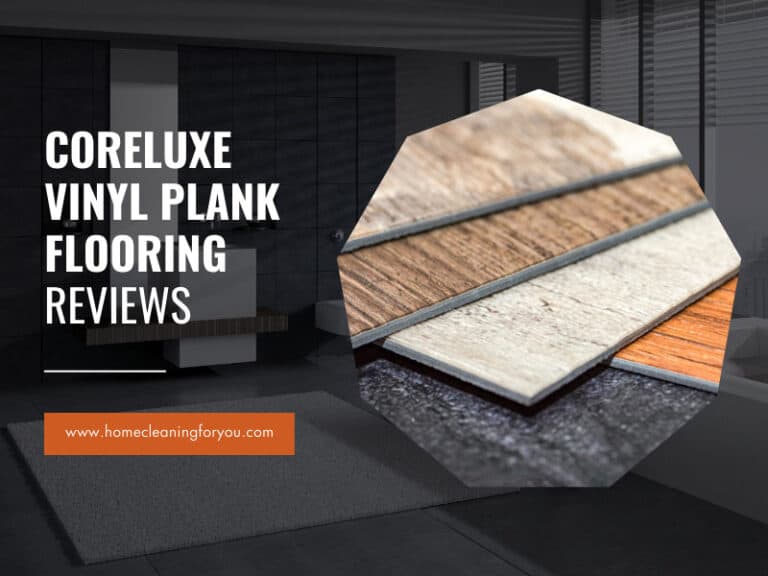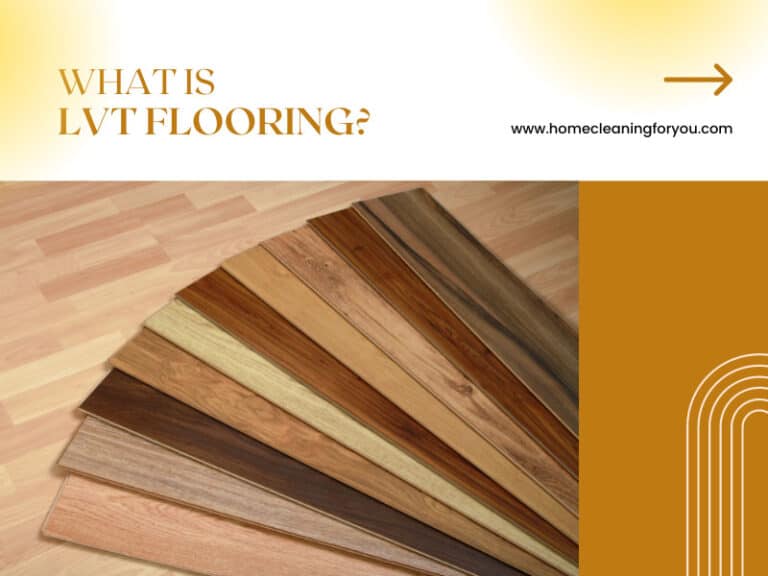What Is Resilient Flooring: The Only Resource You Need 2024

What is resilient flooring? Why do people talk about it a lot these days? Should you choose it for your next flooring project? Everything about resilient flooring will be covered in this article. You don’t need to go anywhere else.
Furthermore, you will also find the advantages and disadvantages and the detailed cleaning and maintenance method for this kind of flooring. Stay tuned and explore them one by one!
Overview Of Resilient Flooring
Let’s get straight to the point. I will provide you with the properties of resilient flooring and how it is used nowadays.
Definition
Resilient flooring does not refer to an individual flooring option. Instead, it is an umbrella term that refers to various kinds of flooring that share the same characteristics. That is firmness and a little bit of giveness and bounciness.
It is described as being in the middle of soft floorings such as carpet flooring and hard floorings like hardwood flooring, ceramic flooring, and stone flooring.
This type of flooring can be made of synthetic or natural material. Most varieties are made of polymers, a material that is highly durable. In addition, resilient flooring comes in a wide range of designs with endless color and texture options.

Common Uses
Given its durable nature and appealing design, resilient flooring is suitable for residential and commercial uses. Whether you choose a flooring solution for your living room, bedroom, or kitchen, resilient flooring is a great choice.
Resilient flooring can handle high foot traffic, making it the perfect choice for commercial and public places.
Design Options
Resilient flooring has 3 kinds of forms, namely sheets, tiles, and planks. Let me go through each of them.
Resilient Sheet
Resilient sheets have a high degree of elasticity. It is very flexible and can be rolled up. This form can come in various widths and lengths, depending on the manufacturer. But the width is almost always much shorter than the length. It is usually between 6” and 16” long.

Resilient Tiles And Planks
Tiles and planks are also 2 popular forms of resilient flooring. They are rather hard and cannot be rolled up like resilient sheets. The difference between tiles and planks is that tiles are square in shape while planks are most of the time rectangles.
Resilient tiles and planks come in various sizes and thickness.

6 Types Of Resilient Flooring That You Can Choose From
As I have explained before, resilient flooring is a group of flooring options. In this section, I will go into detail about each option to give you an overall understanding.
Vinyl Flooring
Vinyl flooring is among the most used flooring options at the moment. It is beautiful, durable, easy to install and maintain, and affordable. This type of resilient flooring also has several subtypes, including luxury vinyl tiles or planks, vinyl composition tile, and solid vinyl tile.

Cork Flooring
If you want natural flooring, then cork flooring is a very good option. It is made from the cork of the oak tree (1). The cork is sliced, ground, and transformed into sheets. Multiple sheets are bound by resins.
Cork flooring is quite expensive compared to other options because it is highly durable and can resist water extremely well. It is also easy to install.

Linoleum Flooring
Linoleum is another natural resilient flooring besides cork flooring. Its materials include limestone, resins, wood, and linseed oil. The best thing about linoleum flooring is that it is non-toxic and safe for the environment.
Linoleum flooring is mostly used in hospitals, schools, and other public places.

Rubber Flooring
Rubber flooring is also among the best flooring options. It can be made from recycled rubber tires or synthetic materials (2). The greatest thing about rubber flooring is that it can withstand a large amount of traffic.
This type of resilient flooring can be found in commercial spaces, such as gyms, cafeterias, and hospitals. It is also used in residential settings.

Asphalt Flooring
You can rarely see asphalt flooring nowadays because it is not widely used anymore. However, it is classified as a type of resilient flooring due to its excellent durability and long lifespan. It is made of asphalts resins, pigments, asbestos fibers, and mineral fillers.
Asphalt flooring is particularly suitable for damp and alkaline areas thanks to its durability and water-resistant property.
Polymeric Poured Seamless Flooring
This kind of flooring is in liquid form. It is poured directly on the floor and becomes solid once cured. However, you will see it very rarely because it is not a popular flooring option.
Advantages And Disadvantages Of Resilient Flooring
This section will help to decide whether you should invest in resilient flooring or not. Consider these advantages and disadvantages carefully. Check the table below for a brief answer.
Advantages
Let me discuss each advantage below so that you have a complete picture of the pros of resilient flooring.
Durability
Resilient flooring is made of strong materials such as wood and plastic compounds. So it can endure a high amount of heavy and foot traffic without getting damaged.
Variety Of Styles
This is one of the characteristics that people love about resilient flooring. You have many options to choose from. It can mimic the look of wood, stone, and ceramic. Whatever design you want for your room, resilient flooring can provide it for you.
Easy Installation
Most types of resilient flooring have a simple installation procedure that you can do by yourself without seeking the help of a professional installer. Just make sure that you strictly follow the instructions.
Resilient flooring is also very easy to maintain. The sheets are crack-resistant while the tiles and planks are equipped with infused additives, making cleaning more simple.
Water Resistance
All types of resilient flooring are water-resistant. This is a huge advantage over non-resilient flooring such as hardwood flooring. Spills can be cleaned easily. So moisture can rarely damage resilient flooring.
Sound Absorben
Resilient flooring will give you a quiet living space because it has the ability to absorb sound. This feature makes it an ideal option for high-traffic places such as public places.
Affordability
Compared to non-resilient floorings like hardwood flooring or ceramic flooring, resilient flooring is much more affordable. It can even resemble the look of these luxurious types of flooring. In addition, you can always find a suitable option with your budget.
Warmth
Resilient flooring offers some warmth when you step on it. This is great for winter when everywhere else is so cold.

Disadvantages
Besides the impressive advantages, resilient flooring also has some drawbacks that you should consider carefully.
Indentations
Since resilient flooring is quite elastic, it can be affected by heavy and small objects such as appliance feet and table legs. This results in indentations that are hard to repair. However, you can prevent it by investing in some floor glides under sharp objects.
Variation In Quality
Another disadvantage of resilient flooring is that the types are not equal in quality. There are high-quality flooring options, such as luxury vinyl flooring. However, some other varieties like vinyl squares are rather low-quality and wear quickly.
Recyclability
Some kinds of resilient flooring, namely vinyl flooring and linoleum flooring, cannot be recycled because they are made of synthetic materials. Yet other varieties, such as cork flooring and rubber flooring, are completely recyclable.

Installing Resilient Flooring: A Concise Guide
Do you want to know how resilient flooring is installed? If yes, this section will help you to have a good imagination of what the installation process looks like.
Step 1: Prepare The Subfloor
As I have mentioned before, resilient flooring cannot be installed on a wet subfloor. So the first thing you have to do is to check whether the subfloor is dry enough or not.
No matter whether you plan to install resilient flooring over an old or new subfloor, a moisture test is always required.
But don’t worry. The test is not complicated at all. All you have to do is put a piece of plastic wrap on the floor and let it sit for several hours. After that, remove it from the floor and look at the back to check whether any moisture is present.
Next, you have to install a moisture barrier to the subfloor. If your subfloor is equipped with hardeners or sealers, you have to remove it. You can test it by applying some water to the subfloor. If the area beads, then there is probably a layer of hardener or sealer on the slab.
Before you install the moisture barrier, make sure you clean the subfloor first to remove all of the dirt and debris.
Finally, you have to ensure that the subfloor is level and free of cracks and other damage. If any imperfection is detected, make sure you make necessary repairs prior to installing resilient flooring.

Step 2: Prepare The Sheets, Planks, Or Tiles
When you buy the resilient sheets, planks, or tiles, you must keep them in the room where you plan to install them 2-3 days before the scheduled installation day. This helps them to adapt to the temperature and humidity of the new environment.
You have to read the manufacturer carefully to know how many hours are required for your resilient flooring type. Furthermore, you need to keep to room temperature at 65° Fahrenheit or above all the time.
Step 3: Daft The Flooring Layout
If you choose resilient flooring that has a specific pattern or style, you have to sketch the layout on graph paper. As such, you will have a good installation plan where the positions of the sheets, planks, or tiles are specified in detail.
Start by making a scale drawing of the place where you install the resilient flooring. Find the center of the room and draw a vertical line and a horizontal line through it to create 4 quadrants.
Next, arrange the flooring units on each quadrant, starting from the center point and moving to the ends. Before you officially install the resilient flooring, cut off ¼ inch of the farthest row to allow the flooring to expand.
Step 4: Install The Resilient Flooring
This step can vary and is dependent on the specific type of resilient flooring that you are installing. Some kind of resilient flooring is installed with a peel-and-stick style. The back of the planks, tiles, or sheet can have a wax paper backing. You just have to press it to the subfloor.
Vinyl sheet flooring is installed using quarter-round molding and shoe molding. For rubber flooring, it is installed much like hardwood flooring. That is to say; it has a tongue-and-groove design.
Note: The installation process involves correctness. You need to ensure perfection in every step.
Let’s see how easy it is to install peel-and-stick resilient flooring.
How Much Does Resilient Flooring Cost?
To install resilient flooring, you need to pay for a number of things, including the cost of the flooring and equipment. If you install it by yourself, you don’t have to pay any labour cost. Here is the general price of each type of resilient flooring for your reference.
As you can see, resilient flooring has a wide range of prices. No matter what your budget is, you can always find a perfect flooring solution for your project.

Resilient Flooring Vs. Non-Resilient Flooring: A Comparison
Opposed to resilient flooring is non-resilient flooring. Let’s see how they are different from each other and which should you choose for your residential or commercial place.
Durability
Both resilient and non-resilient flooring is very durable. Yet, resilient flooring often has problems with indentation, while non-resilient is resistant to almost everything. Thus, non-resilient flooring has higher durability than resilient flooring.
Cost
When it comes to the price, resilient flooring wins. It is much cheaper than non-resilient flooring. This is because non-resilient flooring is made from natural wood, stone, granite, or marble, which are very expensive materials.
Style Option
This is perhaps the only thing that resilient flooring and non-resilient flooring have in common. They both provide you with a wide range of stype options. You can always find a design that you like.
Resilience
This is the typical difference between resilient and non-resilient flooring. While resilient flooring has the ability to bounce back slightly, non-resilient flooring does not. It is completely hard and non-elastic.
Maintenance
The price goes hand in hand with maintenance issues. Resilient flooring price is less expensive. But once it is damaged, the maintenance and repair cost is significantly higher than that of non-resilient flooring.
In addition, non-resilient flooring is easier to maintain than resilient flooring.
Caption: Resilient and non-resilient flooring is different in almost every aspect.
How To Clean Different Types Of Resilient Flooring?
Cleaning methods are crucial for every type of flooring. Luckily, resilient flooring is relatively easy to clean. I will give you the cleaning methods for the most widely-used kinds of resilient flooring, including vinyl flooring, linoleum flooring, cork flooring, and rubber flooring.

Cleaning Methods For Vinyl Flooring
Vinyl flooring should be swept and vacuumed frequently to avoid accumulated dirt and dust. For deep cleaning, you should use either the cleaner that is suggested by your flooring manufacturer or a non-abrasive all-purpose cleaning solution.
If you prefer a DIY cleaning solution, just mix some vinegar with water to clean the vinyl floor. After some time, you will have to polish the floor to protect it from future damage. Acrylic-base and water-based polish are suitable for waxed vinyl flooring.
Cleaning Vinyl flooring is just an effortless task.
Cleaning Methods For Linoleum Flooring
Linoleum flooring is also very easy to clean. For regular cleaning, you just have to sweep and vacuum it frequently. You also have to clean stains immediately after it appears.
In addition, you need to deep clean linoleum flooring once or twice per year to remove accumulated dirt and debris. Common cleaning solutions such as baking soda, vinegar, and mild dish soap also work well on linoleum floors.
A cleaning solution that you can use is the mixture of 1 cup of vinegar, a few drops of dishwashing liquid, and 1 gallon of water.
Linoleum flooring always has a straightforward cleaning procedure.
Cleaning Methods For Cork Flooring
To clean cork flooring, you can use pH-neutral wood or cork cleaner. Do not use ammonia and other harsh cleaners. A DIY alternative is a mixture of 1 part of vinegar and 4 parts of water. You should not leave too much water on the floor as moisture problems may be present.
Don’t forget to sweep and vacuum the cork floor once a week to prevent dust and dirt from building up. Also, always protect it against direct sunlight by installing window treatments.
Some useful cleaning and maintenance tips for cork flooring are here.
Cleaning Methods For Rubber Flooring
The procedure to clean rubber flooring is similar to that of other types of resilient flooring. Vacuum and sweep it regularly and mop it cleaning solution every few months. Use mild dish soap or white vinegar to clean it. Avoid cleaning agents that contain turpentine.
Furthermore, you should also buff the floor to make it shiny and glossy. Use a rubber floor conditioner or a mixture of fabric softener and water. You can use a floor buffing machine to do this task or do it with your hand.
If you use a flooring buffing machine, make sure you set it to the speed of less than 350 revolutions-per-minute.
Cleaning rubber flooring is a bit more complicated. But it is still easy.
Maintenance Tips For Resilient Flooring
Besides cleaning, resilient flooring should be maintained properly. You need to remember these tips in order to keep the flooring clean and undamaged.
- Sweep and vacuum the resilient floor routinely to remove every dirt and dust that builds up. Do not use a vacuum cleaner with a stiff revolving brush.
- Always follow the manufacturer’s instructions on cleaning and maintaining resilient flooring.
- Never use abrasive cleaners and scrub pads to clean the resilient floor. Or else it can be scratched or damaged. It is best to use the cleaner recommended by the manufacturer.
- A product that can both clean and polish the floor can make the floor dirtier and look dull over time. If you use it
- Avoid using strong dishwashing cleaner, soap, and oil-based cleaner to clean resilient flooring.
- Be careful when using vinegar to clean resilient flooring. Only use it when the manufacturer recommends it.
- Place rugs and mats to trap outside dirt so that it cannot attack the resilient flooring.
- Clean off any spill you see on the resilient flooring immediately, or else it can seep into the flooring and cause moisture problems.

FAQs
Before coming to the end of this post, I want to list out the most common questions about resilient flooring to help you understand it even better. Let’s take a look at them.
Will You Choose Resilient Flooring?
Given everything that I have provided about resilient flooring, I hope that you can make a decision on whether to invest in it or not.
In case you have questions about resilient flooring, you can post them here anytime, and I will try my best to help you out.

References
- En.wikipedia.org. 2021. Cork (material) – Wikipedia
- Designingbuildings.co.uk. 2021. Rubber flooring.







Kevin Jones
Home Cleaning Specialist
Expertise: In-depth Knowledge of Cleaning Agents and Their Uses, Advanced Home Sanitization, Techniques Expertise in Cleaning and Maintaining, Various Floor Types, Innovations in Home Cleaning Tools
School: American College of Home Economics
Kevin Jones is a seasoned home cleaning specialist with over a decade of experience in the industry. A stickler for cleanliness and organization, Kevin brings a systematic and innovative approach to home maintenance. His expertise ranges from traditional methods to modern cleaning technology, ensuring homes are not just clean but healthy environments too.